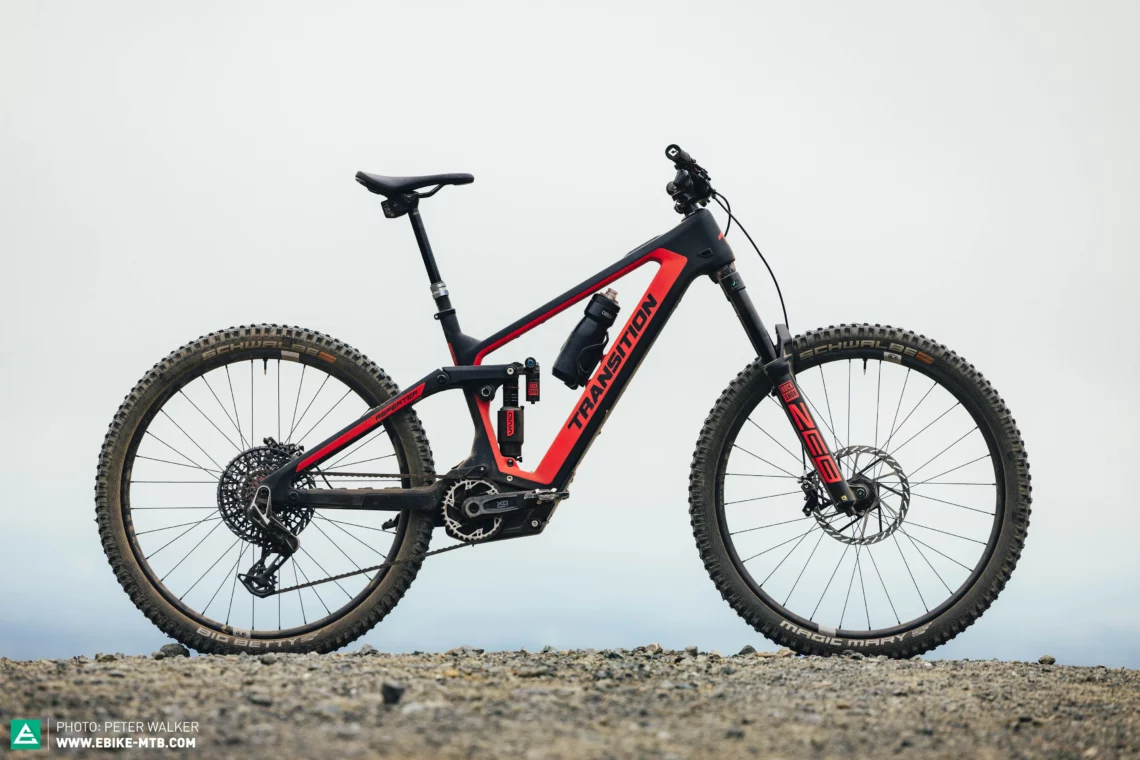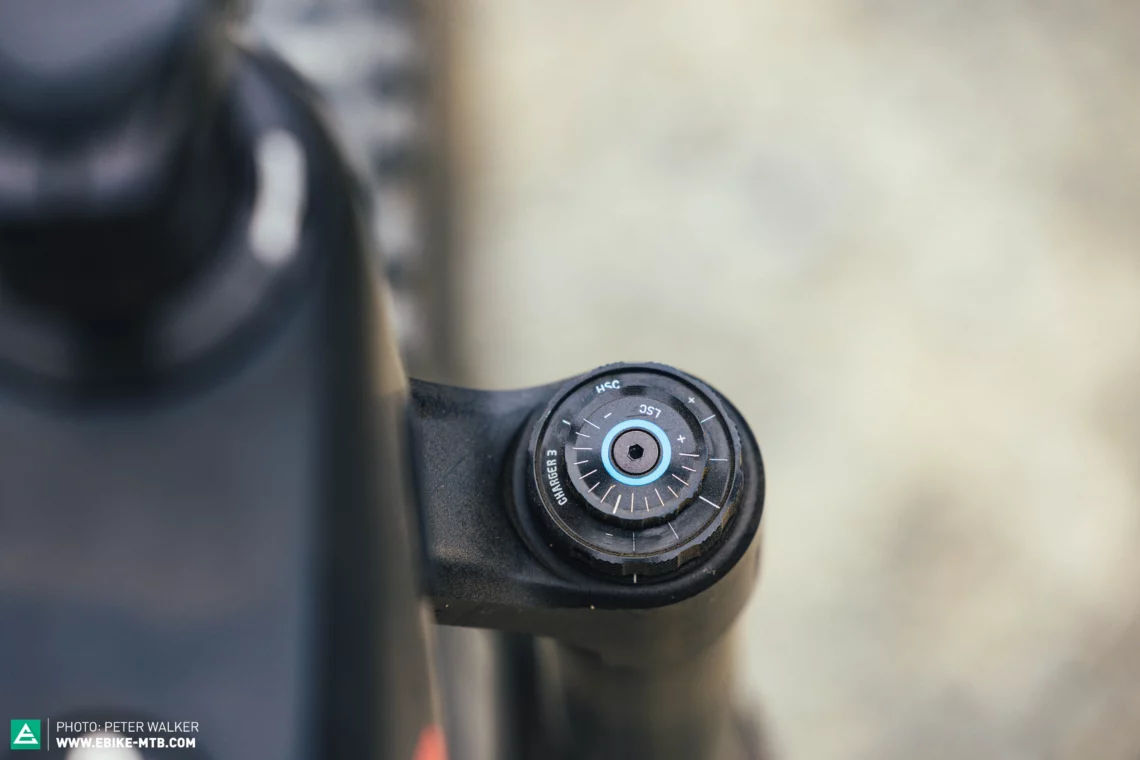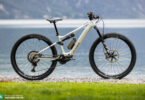Transition just added a new bike to the Repeater model range! The Repeater Powertrain rolls on 29″ wheels and generates 170 mm of travel front and rear. As the name suggests, it comes equipped with SRAM’s brand-new Eagle Powertrain motor with auto-shift function. This all looks pretty promising on paper, but how does Transition’s new eMTB perform on the trail?

24,1 kg in size XL | € 13.399 | Manufacturer’s website
Until now, Transition had two eMTBs in their portfolio: the full-power Repeater and the Relay light eMTB. The first generation of the Transition Repeater has already shown what it’s capable of in our huge e-mountainbike comparison test, in which it stood up against 29 of the hottest eMTBs of the season. With the Repeater Powertrain, the American manufacturer is adding a third ebike to their portfolio. That’s right, the Powertrain variant isn’t meant to replace the conventional Repeater, but rather to expand the model range. Although the new Repeater Powertrain shares the same name and similar styling with the original Repeater, it’s actually a completely different bike. Transition replaced the Shimano EP801 drive with a brand new SRAM Eagle Powertrain motor, which also features the Auto-Shift mode of SRAM’s Transmission drivetrain. Needless to say, this also puts it in a different price category as the Repeater with Shimano motor. The X0 AXS spec variant we tested retails at an eye-watering € 13.399. In return, you’ll get not only a different motor system but also 10 mm more travel, bumping up to 170 mm front and rear, as well as two big 29″ wheels, all tied together with a neat carbon frame. In size XL, the new Repeater Powertrain tips the scales at 24.1 kg.

The Transition Repeater Powertrain X0 AXS 2024 in detail
With its unmistakable styling, the new Repeater Powertrain is distinctly recognisable as a Transition, employing their characteristic Giddy-Up four-bar rear suspension and angular silhouette. While the two-tone paint finish adds a little zest to an otherwise plain colour scheme, the overall design lacks consistency, as the lines don’t match the contours of the frame. To underline the understated look, Transition combine a wireless drivetrain and neat internal cable routing, leaving just the front brake line exposed in the otherwise barren cockpit. The rear brake line disappears into the frame via a cable port on the head tube, and only reappears shortly before the calliper. However, the cable isn’t clamped securely enough, rattling loudly against the frame on the trail. On the other hand, a generously sized seat- and chainstay protector prevents paint chips and chain slap, ensuring a quiet ride on the trail. A minimalist TPU plate on the down tube protects the frame from stray rocks.


The new 2024 SRAM Eagle Powertrain motor system of the 2024 Transition Repeater 2024
As already mentioned, Transition took a new approach with the new 2024 Repeater Powertrain, replacing the Shimano EP801 motor with SRAM’s new Eagle Powertrain motor system, which also includes their Transmission drivetrain with Auto Shift function. This relies on a shifting algorithm to shift gears automatically depending on the riding speed and pedalling cadence. The system also features a Coast Shift function, which allows you to shift gears manually without having to pedal. In a nutshell, the drive unit advances the drivetrain at the chainring to facilitate the shift, but this only works if you’re rolling and the rear wheel and cassette are turning. The Powertrain motor is based on the proven Brose Drive S Mag drive, which also lies at the heart of Specialized’s 2.2 motor. The SRAM Eagle Powertrain delivers 90 Nm of torque and 680 watts peak power. Read our big motor test to find out how the SRAM Eagle Powertrain motor performs on the trail and what features it offers. Compared to the Shimano EP801, SRAM’s new motor is significantly bigger, which also affects the shape of the frame. As a result, the Repeater Powertrain has a beefier bottom bracket area than its Shimano counterpart. The motor draws its power from a permanently integrated 720 Wh battery, which can’t be removed from the frame for charging, meaning that you’ll have to lug your bike inside if you don’t have a garage or basement with a plug. On the other hand, the charging port sits right above the motor, where it’s easily accessible, though the port cover is a little finicky and requires patience to close it properly.


In the top tube of the Repeater Powertrain sits a SRAM AXS Bridge display, which is the control centre of the motor system. Unfortunately, it doesn’t sit flush with the frame, protruding slightly due to the antenna that the display uses to communicate with the other components. The colour display doesn’t flood you with an overwhelming amount of information, and only shows essential riding data such as the support and shifting modes, and battery charge status in percent. Moreover, Transition forgo a remote, instead relying on a pair of SRAM’s AXS pods for a clean, symmetrical cockpit and excellent haptic feedback. However, some of the buttons are assigned with two functions, which takes a bit of getting used to on the trail: for example, you can use the top button of the right Pod to shift to an easier gear by pressing it briefly, or long-press it to toggle the Auto-Shift function. But don’t worry, you quickly get used to the system, and the buttons can also be freely assigned according to your own preferences using the SRAM AXS app.


The spec of our 2024 Transition Repeater Powertrain X0 AXS test bike
For this test, Transition sent the X0 AXS flagship model of the Transition Repeater Powertrain. As the name suggests, shifting is taken care of by an electronic SRAM X0 Transmission drivetrain, which ensures precise shifting performance. The robust rear derailleur is bolted directly to the frame and draws its power directly from the bike’s main battery rather than from an external battery, meaning that there’s one less battery on the bike that needs charging! But there’s a drawback: shifting gears is only an option when the motor is switched on! To round off the AXS-heavy spec, Transition rely on a 170 mm RockShox Reverb AXS dropper post, which is the longest-travel option in the AXS range and is too short for a modern eMTB, restricting freedom of movement on the trail. That’s weird, particularly considering that Transition are known for delivering their bikes with long-travel dropper posts, regardless of the frame size.


RockShox also supply the suspension, consisting of a brand new Vivid Ultimate air shock and beefy ZEB Ultimate fork, which features their top-tier Charger 3.0 damper. Both the shock and fork offer countless adjustment options and deliver an impressive performance on the trail. SRAM CODE RSC Stealth four-piston brakes provide powerful and reliable deceleration, with a big 220 mm front rotor and smaller 200 mm disc at the rear. The Stealth brake levers are angled so that the hoses run parallel to the handlebars rather than arcing forwards, resulting in a less pronounced cable arch and cleaner cockpit. The levers feature tool-free bite point and lever reach adjustments as well as SRAM’s proprietary SwingLink technology, which is designed to minimise deadband and optimise modulation, thus reducing arm pump.



The cockpit consists of a 40 mm ANVL Swage stem, paired with some 800 mm OneUp Carbon handlebars. For the wheels, Transition rely on a Crankbrothers Synthesis E alloy wheelset and Schwalbe tires, combining a Magic Mary in the soft Super Soft rubber compound at the front and Big Betty in the slightly harder Soft compound at the rear. Our test bike comes with the Super Trail casing, the bike comes in series with the robust Super Gravity casing – excellent! Overall, the spec of our Transition Repeater X0 AXS test bike doesn’t leave much to be desired.


Transition Repeater Powertrain X0 AXS
€ 13,399
Specifications
Motor SRAM Eagle Powertrain 90 Nm
Battery SRAM Battery 720 Wh
Display SRAM AXS Bridge Display
Fork RockShox ZEB Ultimate 170 mm
Rear Shock RockShox Vivid Ultimate 170 mm
Seatpost RockShox Reverb AXS 170 mm
Brakes Die SRAM CODE RSC-Stealth 220/200 mm
Drivetrain SRAM X0 Eagle Transmission 1x12
Stem ANVL Swage 40 mm
Handlebar OneUp Carbon 800 mm
Wheelset Crankbrothers Synthesis E 29"
Tires Schwalbe Magic Mary Super Gravity Ultra Soft/Big Betty Super Gravity Soft 2.4"
Technical Data
Size SM MD LG XL
Weight 24.1 kg
Trailer approval no
Kickstand mount no
Available spec variants of the new 2024 Transition Repeater Powertrain
Alongside the X0 AXS flagship model we tested, Transition also offer a more affordable GX AXS spec variant for € 11.799. As the name suggests, this comes equipped with a SRAM Transmission GX drivetrain, which like its higher end counterparts, supports SRAM’s Auto and Coast Shift functions. Like the flagship Repeater Powertrain model, the GX AXS variant relies on RockShox suspension consisting of a ZEB fork and Vivid Select+ air shock. The fork employs a more basic Charger RC damper, which is quick and easy to adjust but lags behind its top-tier Charger 3.0 counterpart in terms of Trail performance. The shock, on the other hand, is pretty much identical to the Ultimate flagship model, only without an externally adjustable high-speed compression setting. For the rest of the spec, the GX AXS variant shares the same spec as the X0 AXS model, except for the DT Swiss H1900 Spline alloy wheelset. All spec variants are available in two colours, Graphite Grey and Bonfire Red.

The geometry of the 2024 Transition Repeater Powertrain 2024
The Transition Repeater Powertrain is available in four sizes, SM, MD, LG and XL, and relies on a modern geometry with a slack 63.5° head tube angle. Chainstay length is 455 mm across the board and doesn’t grow with the frame size. At 440 mm in LG, the seat tube is relatively short, but still allows you to insert the dropper post all the way into the frame – not that you’re likely to need to with the standard 170 mm RockShox post, which is simply too short for a potent e-enduro bike like the Repeater.
| Size | SM | MD | LG | XL |
|---|---|---|---|---|
| Top tube | 551 mm | 584 mm | 615 mm | 654 mm |
| Seat tube | 380 mm | 400 mm | 440 mm | 470 mm |
| Head tube | 110 mm | 115 mm | 125 mm | 135 mm |
| Head angle | 63.5° | 63.5° | 63.5° | 63.5° |
| Seat angle | 79.2° | 78.5° | 78.2° | 77.5° |
| Chainstay | 455 mm | 455 mm | 455 mm | 455 mm |
| BB Drop | -25 mm | -25 mm | -25 mm | -25 mm |
| Wheelbase | 1.230 mm | 1.262 mm | 1.292 mm | 1.326 mm |
| Reach | 425 mm | 455 mm | 480 mm | 5510 mm |
| Stack | 630 mm | 635 mm | 643 mm | 652 mm |

The new 2024 Transition Repeater Powertrain 2024 on the trail
As soon as you swing your leg over the saddle, the Transition Repeater Powertrain X0 AXS places you in a central, comfortable riding position that’s also suited for long tours. Riding uphill, the rear suspension generates plenty of traction and only bobs slightly, allowing you to make your way to the trailhead without having to activate the climb switch. The long chainstays prevent the front wheel from lifting off the ground, making it easy to negotiate even steeper climbs without actively weighting the front wheel. The SRAM Eagle Powertrain motor pushes hard enough to overcome steep climbs without getting to the trailhead in a sweat bath. However, the Auto-shift function quickly reaches its limit for sporty riders on steep and technical climbs, shifting gears when you probably wouldn’t. For example, when building up speed at a high cadence to overcome an obstacle, the system automatically shifts into a bigger gear, making it hard to clear the obstacle. Automatic shifting is a decent option for cruising to the trailhead in relaxed fashion, but doesn’t work on technical climbs.

Overall, the Repeater Powertrain feels just like it looks, delivering a rather underwhelming riding performance on the trail. While the central riding position is pretty comfortable, the Repeater feels sluggish on flowing trails, requiring a great deal of physical effort to spontaneously change direction or flick the bike into corners. Moreover, the suspension swallows up the rider’s input, making it hard to generate speed by pumping through rollers and berms. On the other hand, the composed rear suspension and the tire’s grippy Super Soft rubber compound generate plenty of traction. With bigger jumps, the Repeater feels composed mid-air, inspiring huge amounts of confidence but also making it harder to whip, or have fun with the terrain. When the trail gets rougher, the Transition impresses with stoic composure and sticks to the ground like Velcro, with the high front end taking the edge off steep descents. With the Auto Shift function activated it’s hard to understand which gear you’re in, because the algorithm shifts gears rather often. And while the gear choice is pretty sensible most of the time, with hard, sudden braking manoeuvres, the automatic function doesn’t react quickly enough, meaning that you’re still in a harder gear when you resume pedalling. If you find yourself in this situation, we recommend deactivating the automatic function and use the Coast Shift function instead, which enables pedal-free shifting.


Which Repeater suits you best? SRAM vs Shimano version!
While the two bikes share the same name and a few details, they’re very different from one another. Motor integration is sub-par with both models, but the new Repeater’s SRAM Eagle Powertrain drive system has a few more tricks up its sleeve. The Auto-Shift function is only really of any benefit for leisurely cruising, but the Coast-Shift function – which allows you to shift gears without pedalling – brings some clear advantages to the trail. Alongside the gimmicks, the SRAM motor system also delivers more power than the Shimano drive, which ensures more oomph on steep climbs. Although the new Repeater Powertrain relies on a bigger battery than its Shimano counterpart (720 vs 630 Wh), and enables a bigger range as a result, the Shimano variant clearly proves that size isn’t everything on the trail, enabling more agile handling and rewarding active riders with tons of speed and a bigger grin factor, thus proving the better all-rounder between the two. The new Repeater Powertrain, on the other hand, feels more composed and inspires huge amounts of confidence on the trail, which comes at the expense of agility on narrow and flowing trails.


Our conclusions about the new 2024 Transition Repeater Powertrain
The new Repeater Powertrain X0 AXS is a welcome addition to Transition’s portfolio, but while it gains power, range and travel, it loses agility and pop. Flow trails and tight corners aren’t its natural habitat and require a fair amount of physical effort. On the other hand, the Repeater Powertrain feels at home on straighter, rough trails, where it conveys huge amounts of confidence. Auto Shift works fine on relaxed tours, but fails to convince on technical trails, where the Coast Shift function is a much better option. As far as all-round qualities go, the Repeater Powertrain has to admit defeat to its Shimano EP801 counterpart.
Tops
- Plush rear suspension generates plenty of traction
- Inspires huge amounts of confidence
- Gravity-oriented spec
- complete, integrated package consisting of the motor system and drivetrain
Flops
- Feels underwhelmed on moderate trails
- Sluggish handling
- Auto Shift reaches its limits on technical trails
For more info, visit transitionbikes.com

Did you enjoy this article? If so, we would be stoked if you decide to support us with a monthly contribution. By becoming a supporter of E-MOUNTAINBIKE, you will help secure a sustainable future for high-quality cycling journalism. Click here to learn more.
Words: Mike Hunger Photos: Peter Walker





















